Appcues vs Product Fruits: Which is Best for Your SaaS?
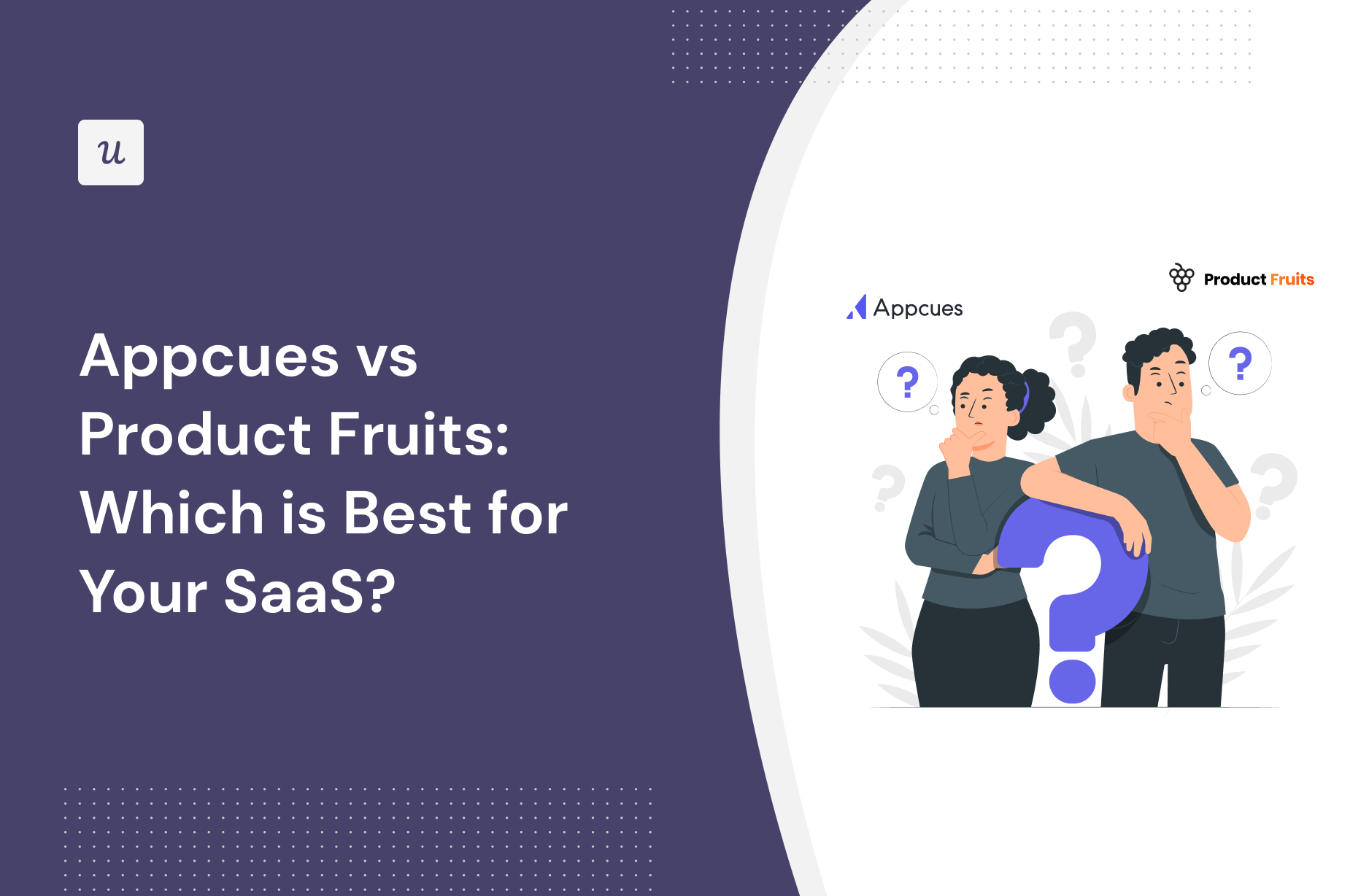
Wondering whether Appcues or Product Fruits is the best option for your SaaS company?
This article is going to dive into the Appcues vs Product Fruits debate and try to answer a key question: Which is the better tool for user onboarding, as well as other use cases?
In the post below, we’ve covered all the common use cases and done an in-depth analysis of the key features of Appcues and Product Fruits – as well as compared it to an alternative solution that may be better in some situations.
Let’s get into it!
TL;DR
- Let’s explore how Appcues, and Product Fruits compare when it comes to user onboarding and other common use cases.
-
- Appcues is a robust product adoption and user onboarding platform for web and mobile apps. It enables product teams to create, implement, and test personalized in-app onboarding experiences. The platform also helps you announce new product features and collect customer feedback.
- Product Fruits is a platform designed to help you tackle issues related to software adoption. With a focus on seamless customer onboarding, this tool allows companies to create engaging in-app journeys.
-
- If you’re looking for a better option for user onboarding, Userpilot exceeds both functionality and value for money compared to other tools on the list.
- Userpilot is a product growth platform that drives user activation, feature adoption, and expansion revenue. It also helps product teams collect user feedback, streamline onboarding, and gather actionable insights from analytics. Get a Userpilot demo for user onboarding and drive your product growth code-free.
![]()
Userpilot – A Better Alternative for Your SaaS

What is Appcues?
Appcues is a robust product adoption and user onboarding platform for web and mobile apps. It enables product teams to create, implement, and test personalized in-app onboarding experiences. The platform also helps you announce new product features and collect customer feedback.
What makes this platform even better is the fact that it offers no-code features that make it suitable for non-technical teams. 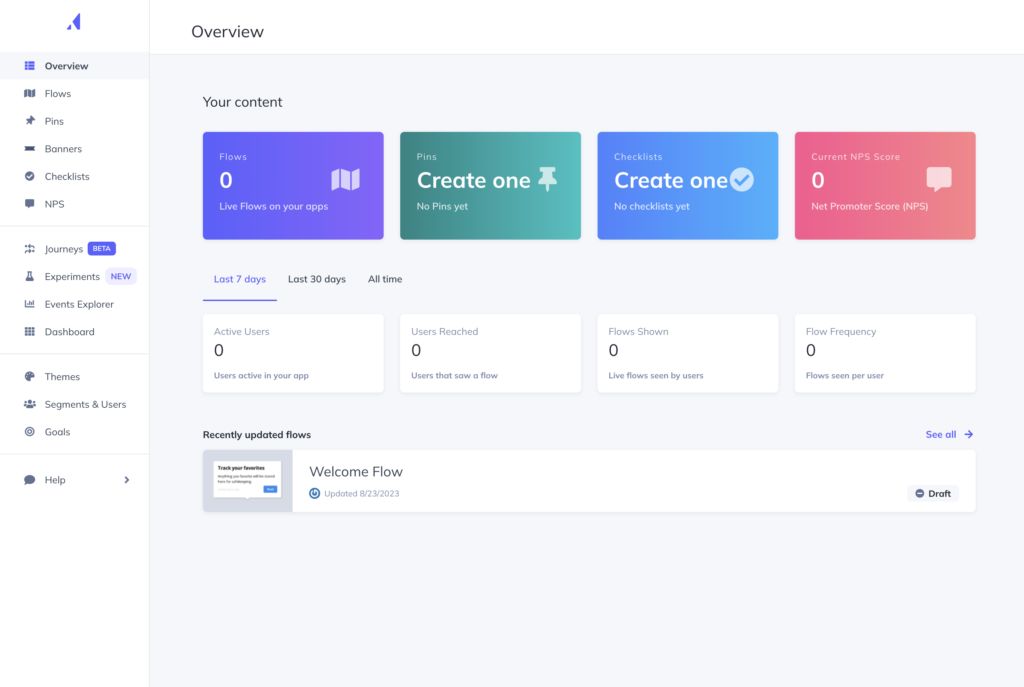
What is Product Fruits?
Product Fruits is a platform designed to help you tackle issues related to software adoption. With a focus on seamless customer onboarding, this tool allows companies to create engaging in-app journeys.
The platform provides insights into successful practices, guiding you toward steady business growth. Best of all, you don’t need any coding skills to get started with Product Fruits.
Appcues vs Product Fruits for user onboarding
In this section of the article, we’re really going to compare Appcues vs Product Fruits in terms of user onboarding. That way, we’ll be able to figure out which tool – Appcues or Product Fruits – is the best option depending on your use case.
Appcues for user onboarding
Onboarding new users seamlessly is one of the primary use cases of Appcues. The platform offers a wide array of features to help you improve user activation, conversion, and retention.
Let’s take a closer look at how Appcues facilitates new user onboarding:
- Drag-and-drop builder: Appcues’s no-code builder lets you create personalized onboarding tours and checklists to assist and educate new users. You can customize UI patterns like hotspots, modals, slideouts, and tooltips to guide users.
- In-app user guides and product tours: You can use various UI patterns, such as hotspots and tooltips, to introduce new users to product features in a pre-defined sequence. Similarly, you can use checklists to guide users as they explore your app.
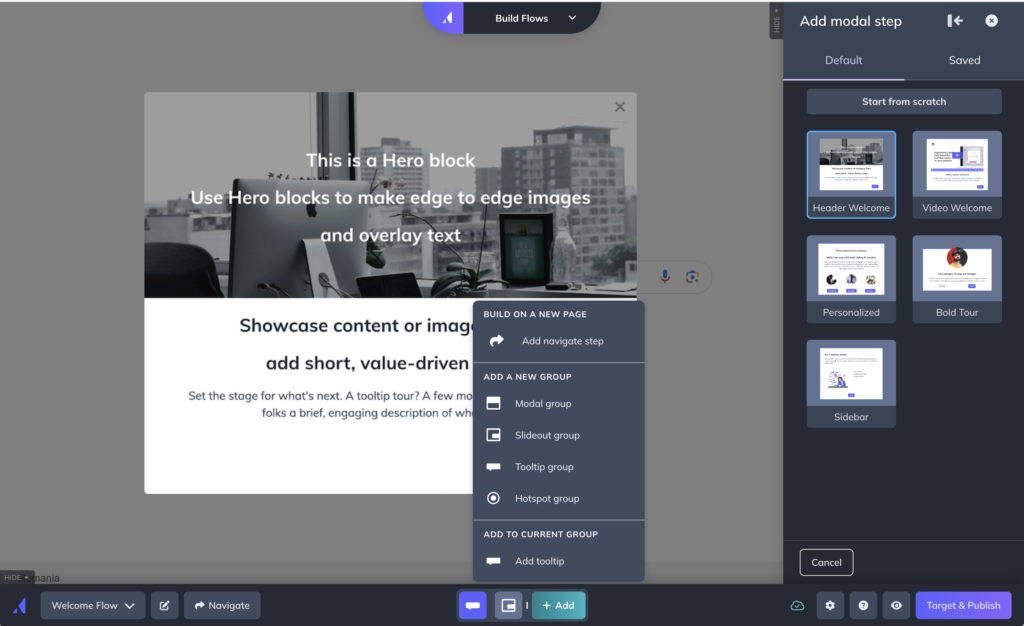
- Checklists: You can also create checklists with Appcues (NOT available on the Essentials plan) and prompt users to take action. These are ok but have limited functionality (you can’t trigger JS functions or add gamification elements) compared to alternatives, such as Userpilot.
- Segmentation: You can use one of the pre-defined audience segments or create customer segments based on plan tier, lifecycle stage, and other factors. It’s possible to target individual segments with personalized messaging and journeys.
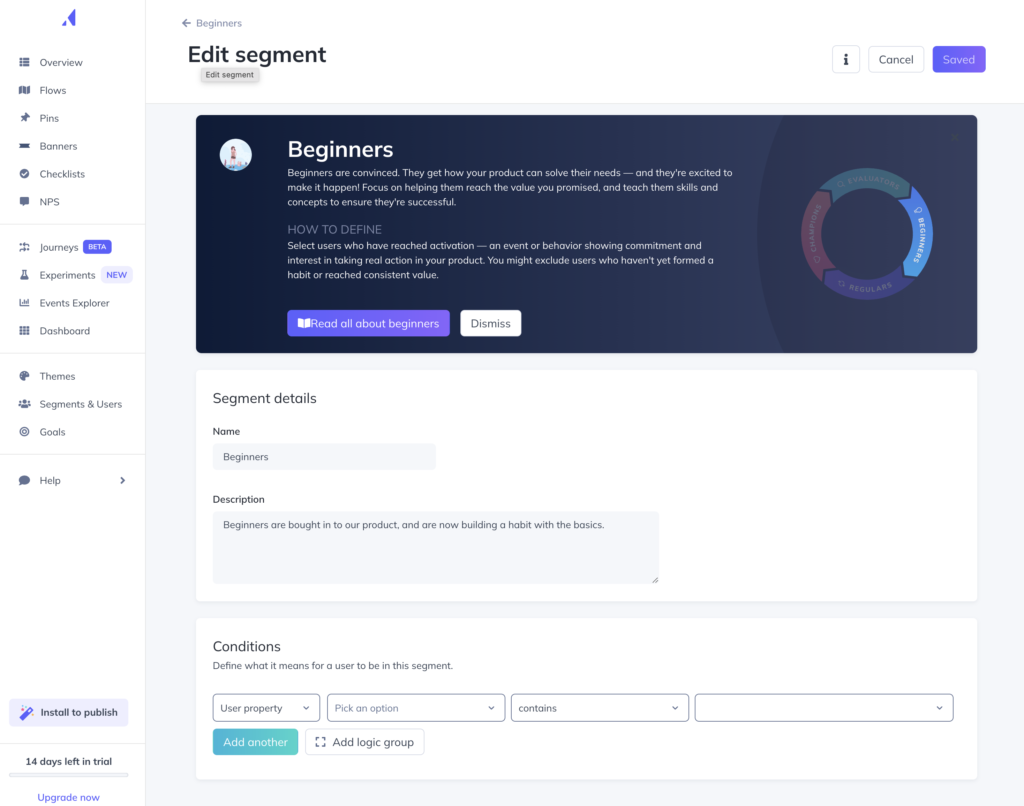
- Measure and improve: You can track in-app flow performance and measure events (limited to 5 on the Essentials plan) to identify areas of improvement.
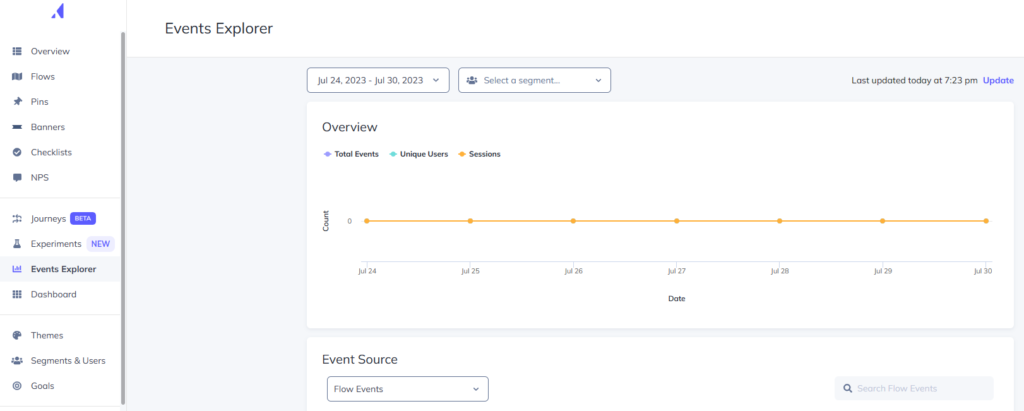
- Test and optimize: The newly introduced A/B testing feature lets you test different onboarding flows. You can compare the performance of different in-app sequences, identify the best-performing ones, and refine onboarding flows.
Product Fruits for user onboarding
If you’re looking for a tool to simplify your user onboarding process, Product Fruits can be your go-to. This software teaches your customers the ins and outs of your product. Moreover, its affordability makes it an appealing choice for budget-conscious small startups.
Here’s why Product Fruits can shine in your onboarding toolkit:
- Product Tours: Product Tours are a great way to welcome and introduce new users to your product. With Product Fruits you can craft step-by-step guides and embed videos from YouTube or Vimeo for interactive understanding. You can create cards that highlight your unique selling propositions to generate excitement. Additionally, the tours offer the option for users to initiate further exploration via a hint icon or special button. Want insights of your product tour? use Product Fruits Analytics features. It offers data on user interactions, completion rates, time spent, and more, helping you fine-tune your tours.
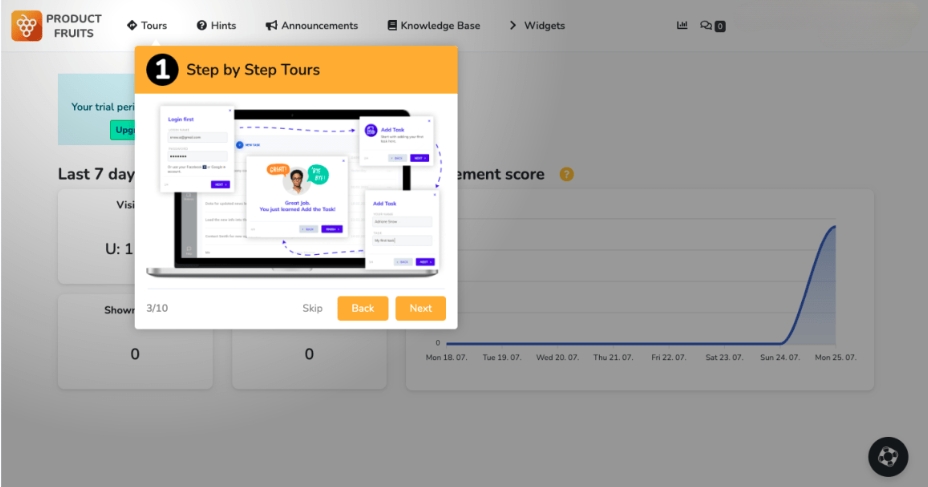
- In-app Announcements: Product Fruits uses pop-ups that appear over all other content, ensuring that users will see these messages before product tours. These pop-ups can be utilized for one-time announcements and are considered one of the best ways to share promotional content. Alongside pop-ups, Product Fruits offers a newsfeed feature. It lets you publish updates about your product in various formats. The newsfeed widget can be embedded into your application and will appear when a user clicks on an icon. A common practice is to use a bell icon accompanied by a badge showing the number of unread newsfeed items.
- Knowledge Base: This constitutes a database of information that users can use for assistance at any time. It simplifies article version management, allowing you to create work-in-progress versions and publish updates to production without altering the URL. Moreover, it’s possible to launch your help center on a personalized domain and integrate it into the structure of your website. The Life Ring Button allows users to directly access your web-based application’s knowledge base from anywhere on your product. And the best part? You don’t need any coding to do that.

Appcues vs Product Fruits for product adoption
In this section of the article, we’re really going to compare Appcues vs Product Fruits in terms of product adoption. That way, we’ll be able to figure out which tool – Appcues or Product Fruits – is the best option depending on your use case.
Appcues for product adoption
Appcues packs robust features to skyrocket free-to-paid conversions and drive upsells. Let’s take a closer look at how the platform facilitates product adoption.
- No-code builder: The no-code builder on Appcues lets you create onboarding flows that handhold users through your app. You can also use it to publish in-app announcements that draw a user’s attention to new features and upcoming events.
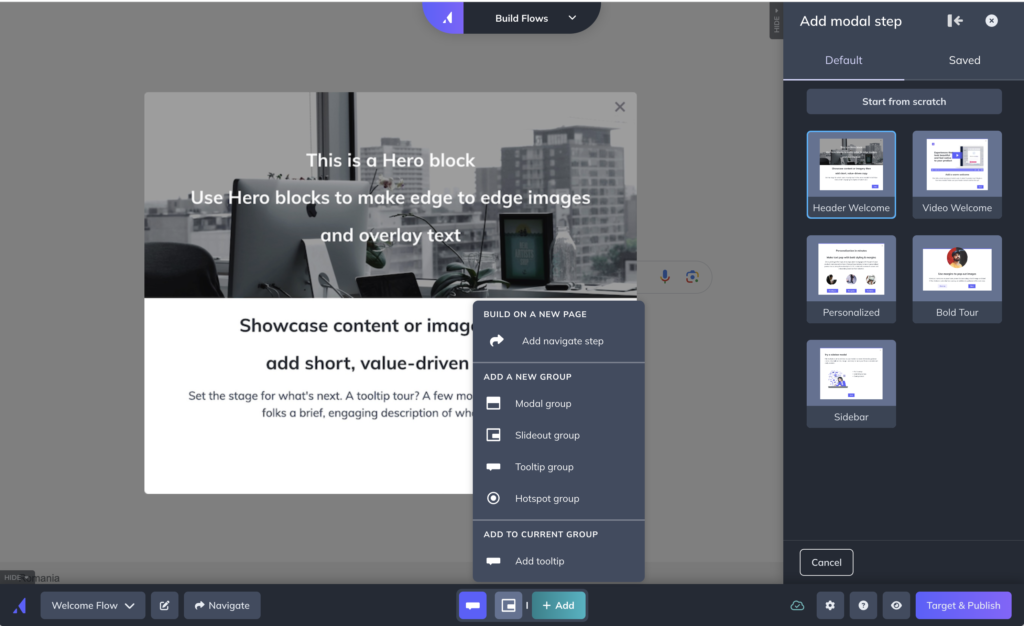
- Pre-designed templates: You can choose from many pre-made templates for each UI pattern. It’s easy to create product tours, in-app tutorials and announcements with these templates.
- Flow targeting: Appcues lets you segment users into different groups based on in-app activity, online behavior, and lifecycle stage. That makes it easier to customize your messaging and win over each segment, helping you convert trials into paying customers.
- Review prompts: Available on Appcues Mobile, this feature lets you nudge users to rate and review your app on various app stores at the right time. It can help drive new sign-ups as well.
- Other features, such as event tracking and A/B testing, can also help improve product adoption.
As you can see, Appcues is focused on in-app experiences but is limited by product analytics. Without proper data is hard to understand how your users are adopting your product and where they need help.
You can integrate Appcues with tools like Amplitude, but that comes at an additional cost. If you are looking for a product adoption tool, Appcues might not be the best.
Product Fruits for product adoption
If you’re looking for a tool to simplify your user onboarding process, Product Fruits can be your go-to. This software teaches your customers the ins and outs of your product. Moreover, its affordability makes it an appealing choice for budget-conscious small startups.
Here’s why Product Fruits can shine in your onboarding toolkit:
- Product Tours: Product Tours are a great way to welcome and introduce new users to your product. With Product Fruits you can craft step-by-step guides and embed videos from YouTube or Vimeo for interactive understanding. You can create cards that highlight your unique selling propositions to generate excitement. Additionally, the tours offer the option for users to initiate further exploration via a hint icon or special button. Want insights of your product tour? use Product Fruits Analytics features. It offers data on user interactions, completion rates, time spent, and more, helping you fine-tune your tours.

- In-app Announcements: Product Fruits uses pop-ups that appear over all other content, ensuring that users will see these messages before product tours. These pop-ups can be utilized for one-time announcements and are considered one of the best ways to share promotional content. Alongside pop-ups, Product Fruits offers a newsfeed feature. It lets you publish updates about your product in various formats. The newsfeed widget can be embedded into your application and will appear when a user clicks on an icon. A common practice is to use a bell icon accompanied by a badge showing the number of unread newsfeed items.
- Knowledge Base: This constitutes a database of information that users can use for assistance at any time. It simplifies article version management, allowing you to create work-in-progress versions and publish updates to production without altering the URL. Moreover, it’s possible to launch your help center on a personalized domain and integrate it into the structure of your website. The Life Ring Button allows users to directly access your web-based application’s knowledge base from anywhere on your product. And the best part? You don’t need any coding to do that.

Appcues vs Product Fruits for customer experience
In this section of the article, we’re really going to compare Appcues vs Product Fruits in terms of customer experience. That way, we’ll be able to figure out which tool – Appcues or Product Fruits – is the best option depending on your use case.
Appcues for customer experience
Appcues plays a key role in taking your product’s customer experience (CX) up a notch.
It helps enhance CX in the following ways:
- UI patterns like checklists, hotspots, modals, and tooltips let you create guided in-app tours and tutorials and simplify customer onboarding.
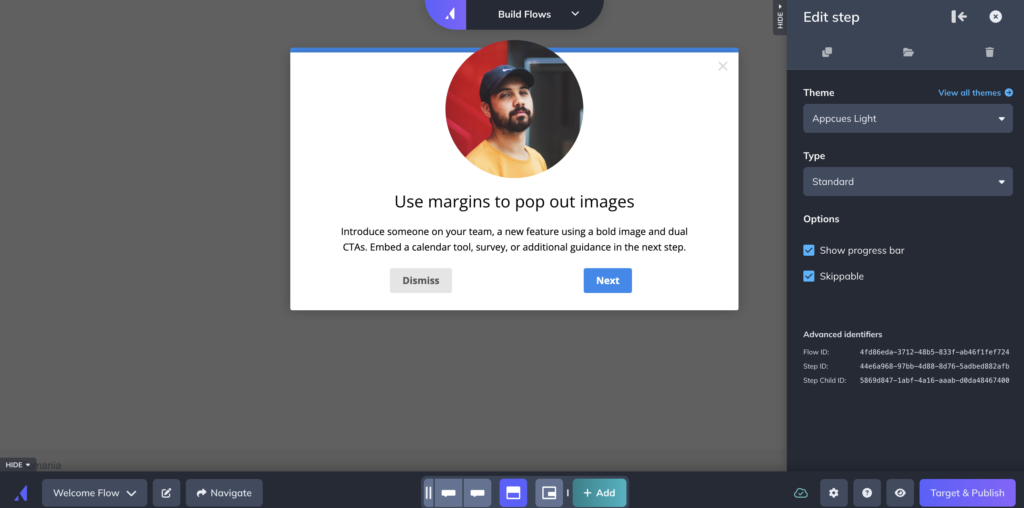
- A Launchpad lets users access Appcues onboarding flows from a notification dropdown within your product.
- NPS surveys help you collect customer feedback and improve your product. However, unlike Userpilot, Appcues only offers NPS surveys.
- Other features like user segmentation (for personalization) and event tracking also come in handy.
That said, Appcues alone can’t guarantee a flawless customer experience. It only covers the onboarding aspect of CX. You’ll need to focus on other aspects like customer support and relationship-building to improve the overall UX, and for those you need multiple types of user surveys, on-demand support (using a resource center) and proper analytics, which Appcues lack.
Product Fruits for customer experience
Customer experience is all about ensuring a smooth and hassle-free interaction when using the product or service.
Now, how exactly can Product Fruits ramp up your customer experience?
- Dashboard: This feature enables you to monitor user onboarding progress and critically evaluate your onboarding strategies’ effectiveness.
- Feedback Management: This is a systematic process that involves collecting, tracking, and analyzing customer feedback. Product Fruits does this by offering useful tools like the Adoption Meter and the Feedback Widget to gauge customer sentiments and identify potential issues. You can submit these issues in the form of images or videos. The platform also provides NPS Surveys to assess customer loyalty over time. These insights drive continuous improvements in products and services and enhance the overall customer experience.
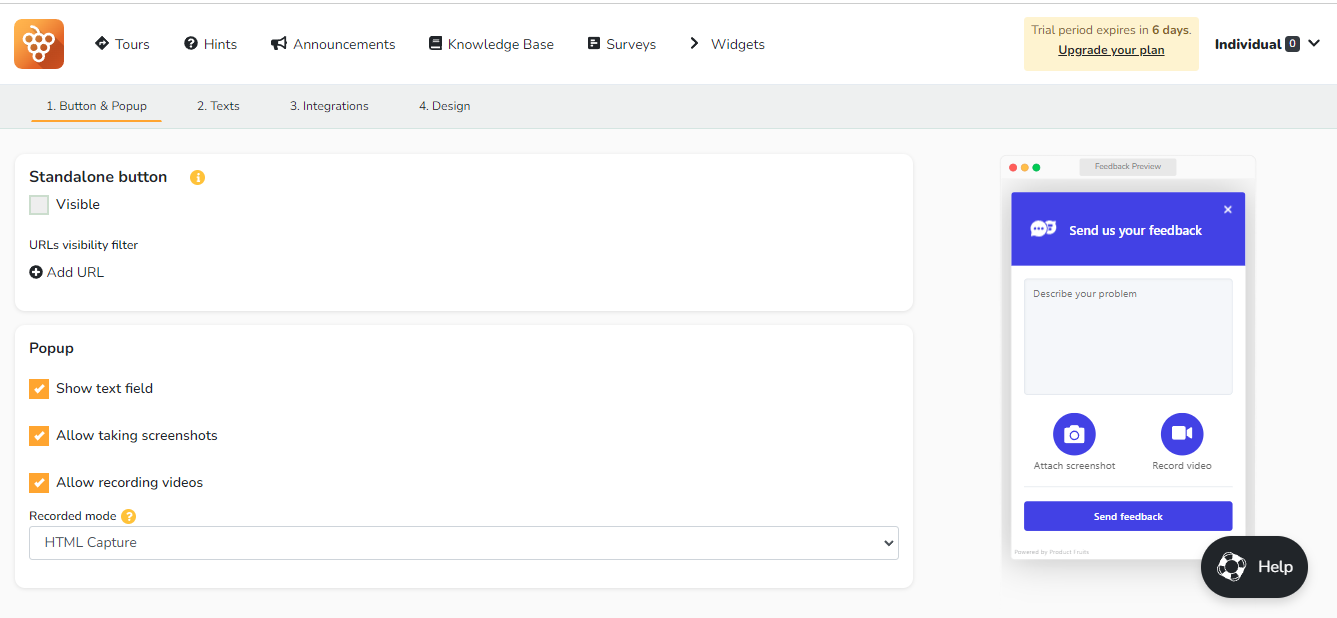
- Knowledge Base: This is a collection of helpful information that users can access whenever they need help. You can quickly get to your knowledge base articles through the Life Ring Button or a Hint icon. Moreover, Product Fruits offers an easy-to-use WYSIWYG editor that makes creating content easy.
Appcues vs Product Fruits for user feedback
In this section of the article, we’re really going to compare Appcues vs Product Fruits in terms of user feedback. That way, we’ll be able to figure out which tool – Appcues or Product Fruits – is the best option depending on your use case.
Appcues for user feedback
Appcues provides a robust suite of tools to collect and analyze your product feedback for mobile apps. However, if you want to collect feedback for your web app, you only have access to an NPS survey.
Mobile app product feedback features include:
- Survey prompt asking a user to rate their experience of using a specific feature.
- Survey forms asking users about feature improvements or new features they’d like to see in your product.
- Collect and analyze NPS survey results to improve in-app experiences.
- App Store review prompts to encourage promoters to rate and review your product on leading app stores.
Product Fruits for user feedback
Collecting feedback with product tools and enhancing your product based on these insights helps your customers feel acknowledged and valued.
Product Fruit employs these strategies:
- NPS Survey: An easy and consistent method to evaluate and monitor your customers’ loyalty over a period of time.
- Churn Survey: With this survey, you can investigate why users stop using your product. In addition, you can offer rewards to keep them on board.
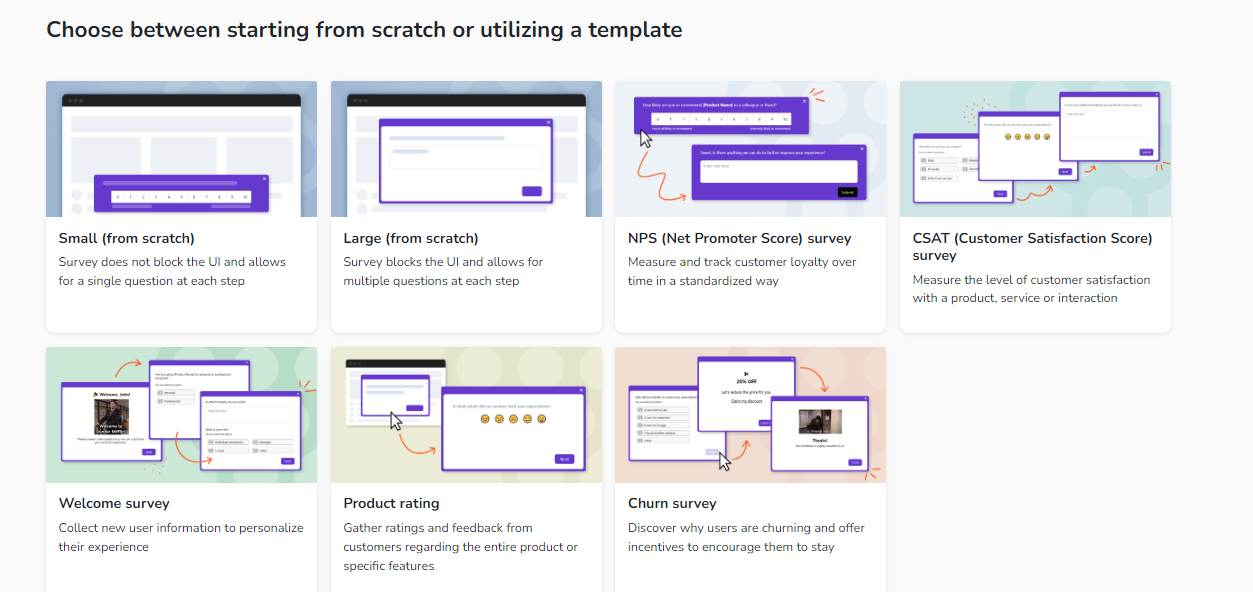
- CSAT: This feature measures customer satisfaction with a product, service, or interaction. It provides valuable insights into areas that need improvement.
- Product Ratings: Enables user-driven ratings and reviews for the product or specific features. It helps identify the product’s strong and weak points.
If you want more control over your surveys and want to use the results in more detail, you should use Userpilot instead. It allows for more effective feedback collection and instant application of collected data to segment your user base and trigger the right experience.
Appcues vs Product Fruits: Which one you should choose?
To further simplify this selection process, let’s break down the strengths and limitations of each tool. Understanding the distinct advantages and potential drawbacks of Appcues and Product Fruits will provide you with a detailed roadmap for making a well-informed decision!
Pros and cons of Appcues
Pros of Appcues
As a first-comer in the no-code product adoption landscape, Appcues offers several valuable features. It’s suitable for mid-market SaaS businesses looking for a simple, easy-to-use tool that enhances user onboarding, retention, and the overall customer experience.
Let’s take a closer look at the benefits of Appcues:
- Intuitive UI and UX: Appcues offers a straightforward interface that’s easy to navigate and use. Users with non-technical backgrounds can design captivating in-app flows and onboarding journeys with its simple drag-and-drop builder. You can tailor user journeys with various UI patterns, from modals and hotspots to tooltips, slideouts, and banners.
- Simple setup: You can get started with Appcues in minutes by adding the SDK to your app’s source code or integrating Appcues with Segment or Google Tag Manager. Then, add a Chrome extension to launch the Appcues Builder in a few quick clicks and start creating in-app flows.
- Feedback options: Create Net Promoter Score (NPS) surveys to collect actionable user feedback. You can even check and analyze NPS analytics on your Appcues dashboard.
- Mobile onboarding: Besides web apps, you can use Appcues to create end-to-end experiences for mobile apps. It supports various mobile environments, including Native Android, Native iOS, React Native, Flutter, and Iconic.
- Extensive integrations: Appcues integrates with 20+ email automation, CRM, and analytics tools, including Heap, Zapier, HubSpot, Google Analytics, and Google Tag Manager. Many of these include two-way integrations.
Cons of Appcues
Appcues comes with a ton of useful features you’d expect from a leading product adoption platform, but it does have a few shortcomings.
Let’s look at a few drawbacks of Appcues:
- Poor element detection: The Appcues algorithm occasionally struggles to detect in-app elements, unlike some of its competitors like Userpilot. It’s particularly limiting when you want to add tooltips to individual options in a dropdown menu.
- Limited customization capabilities: While Appcues lets you customize pre-designed templates, you’re limited to basic options like font style, size, color, and padding. Advanced customization requires working with CSS code, which can be challenging for non-technical teams.
- Basic analytics: Appcues provides insights into product usage and customer behavior. However, you can’t access in-depth analytics without connecting to a third-party tool like Amplitude or Google Analytics.
- Limited survey options: Appcues lacks variety in feedback collection and survey options and doesn’t offer integrations with other platforms like Google Forms and Typeform. You can only build NPS surveys. This is in contrast to some of its competitors, like Userpilot, which offers an extensive library of customizable survey templates.
- Higher pricing: Starting at $249 per month, the Appcues Essential tier has several constraints, such as limited UI patterns and no custom CSS support. Moreover, localization support is only available in the Enterprise tier. If your app is multilingual, you’ll have to shell out a ton of money to make the most of Appcues.
- No live chat: While Appcues offers educational resources and a help center (Help Docs), customer support is limited to email and phone.
Appcues comes with a ton of useful features you’d expect from a leading product adoption platform, but it does have a few shortcomings.
Let’s look at a few drawbacks of Appcues:
- Poor element detection: The Appcues algorithm occasionally struggles to detect in-app elements, unlike some of its competitors like Userpilot. It’s particularly limiting when you want to add tooltips to individual options in a dropdown menu.
- Limited customization capabilities: While Appcues lets you customize pre-designed templates, you’re limited to basic options like font style, size, color, and padding. Advanced customization requires working with CSS code, which can be challenging for non-technical teams.
- Basic analytics: Appcues provides insights into product usage and customer behavior. However, you can’t access in-depth analytics without connecting to a third-party tool like Amplitude or Google Analytics.
- Limited survey options: Appcues lacks variety in feedback collection and survey options and doesn’t offer integrations with other platforms like Google Forms and Typeform. You can only build NPS surveys. This is in contrast to some of its competitors, like Userpilot, which offers an extensive library of customizable survey templates.
- Higher pricing: Starting at $249 per month, the Appcues Essential tier has several constraints, such as limited UI patterns and no custom CSS support. Moreover, localization support is only available in the Enterprise tier. If your app is multilingual, you’ll have to shell out a ton of money to make the most of Appcues.
- No live chat: While Appcues offers educational resources and a help center (Help Docs), customer support is limited to email and phone.
Pros and cons of Product Fruits
Pros of Product Fruits
Product Fruits offers many benefits with its easy-to-use, no-code platform. It is one of the good solutions for companies looking for affordable user onboarding, product adoption, and product analytics.
So, what does Product Fruits bring to the table? Let’s explore its promising pros:
- Guided Product Tours: It guides users to learn about your app through step-by-step tours for new features.
- Newsfeed: Enhance your users’ connectivity by sharing updates about your product. Additionally, you can set specific newsfeed items which will be displayed in the knowledge base.
- Feedback Through Screenshots and Videos: This feature allows users to send screenshots or videos directly within the app to provide feedback.
- Tooltips: These are brief hints added to different parts of the application to guide users and prevent confusion
- Life Ring Button: A comprehensive support hub that combines all guidance and support resources in one location. This allows users to conveniently access onboarding flows, support documents, and tutorials, no matter what page they’re on.
- Custom Events: Trigger actions based on what users do in your app for more personal interaction.
- Segmentation: Create unique experiences for different types of users and show tailored content to separate user groups.
- Analytics: Gain valuable insights into user behavior, identify improvement areas, and address pain points effectively.
- AI Writer: This feature instantly generates your onboarding copy. However, it is only available in higher-tier plans.
Cons of Product Fruits
While Product Fruits does have its merits, it’s not without its share of issues. Let’s see some potential drawbacks that might have you considering alternatives.
- Absence of A/B Testing: Product Fruits lacks A/B testing, a vital feature for refining your product tours based on user responses and data-backed insights.
- Basic Analytics: Product Fruits does not offer in-depth analytics as its competitors like Userpilot. This makes it difficult to evaluate user interaction and the success of your onboarding
- Insufficient Segmentation Options: The segmentation options here are only based on user attributes. This means you can’t highlight particular app functions or experiences based on a user’s past actions in your app, which can limit the customization of their experience.
- Missing Event-Based Triggering: The absence of real-time triggers may limit timely content delivery. This could affect the success of all in-app flows, such as product tours, tooltips, walkthroughs, modals, etc.
- Complex Tour Configuration: Configuring tours with specific conditions, especially when tuning CSS selectors, can be challenging and time-consuming.
- Limited Integrations: This tool links up with analytic tools, which is great. However, it doesn’t go beyond that. You won’t be able to bring in your resource center materials or link up your CRM unless you’re a Hubspot user.
Userpilot – A better alternative for your SaaS
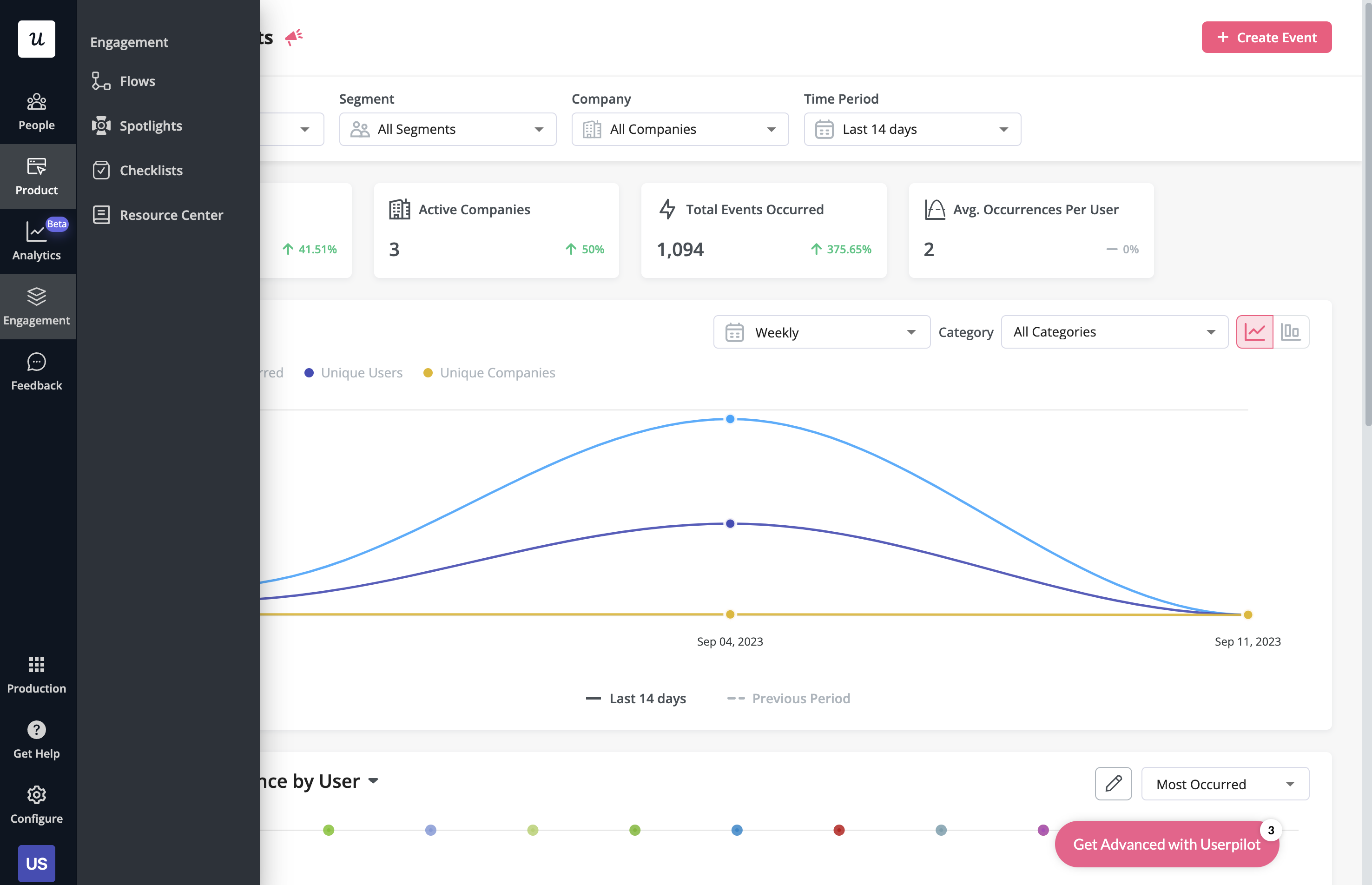 Userpilot is a product growth platform that drives user activation, feature adoption, and expansion revenue. It also helps product teams collect user feedback, streamline onboarding, and gather actionable insights from analytics.
Userpilot is a product growth platform that drives user activation, feature adoption, and expansion revenue. It also helps product teams collect user feedback, streamline onboarding, and gather actionable insights from analytics.
With Userpilot, you’ll be able to track both product usage and user behavior to get a holistic view of how customers use your product — which will guide future development, improve the user experience, and inform your growth efforts.
Pros of Userpilot
As a full-suite digital adoption platform, Userpilot has all the features you need to onboard users, track analytics, and gather feedback from customers without writing a single line of code. Here are a few pros of using Userpilot as your product growth solution:
- No-code builder: Userpilot’s Chrome extension lets you build flows, add UI elements, and tag features without writing a single line of code.
- UI patterns: There are plenty of UI patterns to choose from when using Userpilot, such as hotspots, tooltips, banners, slideouts, modals, and more!
- Startup-friendly: Userpilot’s entry-level plan gives you access to all available UI patterns so you can hit the ground running.
- Walkthroughs and flows: Build engaging interactive walkthroughs and personalized onboarding flows that target specific segments of your user base.
- Self-service support: Build an in-app resource center to help users solve problems, customize its appearance to align it with your brand, and insert various types of content (videos, flows, or chatbots) to keep your customers satisfied.
- A/B testing: Userpilot’s built-in A/B testing capabilities will help you split-test flows, iterate on the best-performing variants, and continually optimize based on user behavior.
- Feedback collection: Userpilot has built-in NPS surveys with its own unified analytics dashboard and response tagging to help you retarget users. There are other survey types to choose from and you can even create your own custom survey.
- Survey templates: There are 14 survey templates to choose from so you can gather feedback on specific features or run customer satisfaction benchmarking surveys like CSAT and CES.
- Advanced analytics: Userpilot lets you analyze product usage data, monitor engagement on all in-app flows, and use the data to create user segments that are based on behaviors instead of demographics.
- Event tracking: Userpilot’s no-code event tracking lets you tag UI interactions (hovers, clicks, or form fills) and group them into a custom event that reflects feature usage.
- Third-party integrations: Userpilot has built-in integrations with tools like Amplitude, Mixpanel, Kissmetrics, Segment, Heap, HubSpot, Intercom, Google Analytics, and Google Tag Manager so you can share data between all the solutions in your tech stack.
Cons of Userpilot
Of course, no tool is perfect and there are a few cons to consider before choosing Userpilot as your user onboarding or product growth solution:
- Employee onboarding: Currently, Userpilot only supports in-app customer onboarding.
- Mobile apps: Userpilot doesn’t have any mobile compatibility which could make it difficult for developers with cross-platform applications to create a consistent user experience for both versions of their product.
- Freemium plan: There’s no freemium Userpilot plan so those bootstrapping their startup and need sub-$100 solutions should consider more affordable onboarding platforms like UserGuiding or Product Fruits.
Conclusion
Hopefully, this post helped you decide whether Appcues or Product Fruits is more appropriate for your company. As you can see – both have many upsides and downsides.
Undeniably, Userpilot provides a better value for money and is a better choice for a mid-market SaaS, especially when it comes to user onboarding and user feedback.
If you’re interested in finding more, book a demo with our team here!
![]()
Try Userpilot – The best user onboarding solution for SaaS


